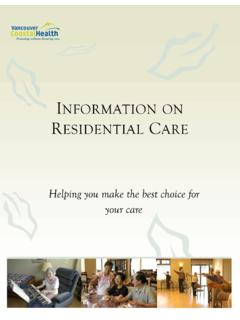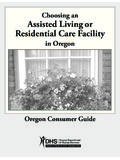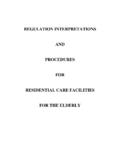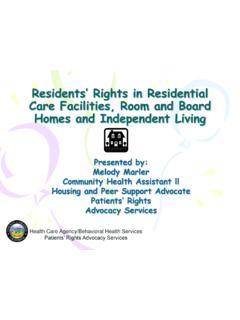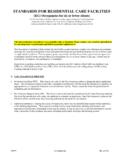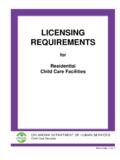Transcription of With the Best Intentions towArds residentiAl cAre in cAmbodiA
1 A study of Attitudes towArds residentiAl care in cAmbodiA With the Best the Best Intentions3A Study of Attitudes towArds residentiAl care in cAmbodiA 2011 AcknowledgementsWe wish to acknowledge with great gratitude all those who supported this study. We express deep appreciation to the research coordinator Camilla Jordanwood and assistant researcher Seng Suy Lim, for their commitment and dedicated hard work over an extended period of time, which ensured quality analysis of rich primary findings from a range of sources covering an under-researched area in cAmbodiA . We extend our appreciation to the Provincial Departments of Social Affairs, Veterans and Youth Rehabilitation and District Offices of Social Affairs, Veterans and Youth Rehabilitation who participated in the initial meetings of the Research Reference Group, as well as interviews and focus group extend our thanks to International Cooperation cAmbodiA - Project Sky and its manager, Sarah Chhin, for allowing the integration into this study of their own baseline research, including invaluable primary data on attitudes of children, young people and directors in residentiAl care , analysis of stakeholder groups and methodology, which was replicated in new locations for the purposes of this study.
2 We would also like to acknowledge FELM for their financial support of the original ICC-Project SKY appreciation is also extended to Friends International and other NGO partners, who contributed valuable support in developing direction and focus, quality control and finalization of the research study as part of the Research Reference special word of thanks to all participants including children, young people, families, national and sub-national government officials, residentiAl care directors, volunteers, tourists, key informants from NGOs and the tourism industry, and adults who had formerly lived in residentiAl care who generously shared information on their lives and donated both their time and ideas to this project. We are humbled by their express thanks to the UNICEF cAmbodiA Child Protection team for their technical guidance and support to realize this research study.
3 Last but not least, we wish to acknowledge USAID and the German National Committee for UNICEF for their generous financial support that made this study the Best Intentions4A Study of Attitudes towArds residentiAl care in cAmbodiA 2011 ForewordUnder the leadership of Samdach Hun Sen, Prime Minister of the Royal Government of cAmbodiA , the Kingdom of cAmbodiA has been progressing and has made achievements in all sectors, including child welfare. A Policy on Alternative care for Children was adopted in 2006, which aims to ensure that children grow up in a family and in a community environment and promotes the principle that institutional care should be a last resort and a temporary solution for children. In 2006, Minimum Standards on residentiAl care for Children were adopted, and in 2008 another set of Minimum Standards on Alternative care for Children in the Community saw daylight.
4 Both Minimum Standards set standards for residentiAl and community-based care facilities and their care for children. In 2009, the implementation of the Policy on Alternative care was further strengthened by the development on a draft Prakas on Procedures for Implementation of the Policy on Alternative care , which establishes a child welfare system in principle that institutional care should be a last resort and a temporary solution has not been fully engrained in the general mindset in cAmbodiA , where the number of institutions and children living in residentiAl care continues to rise each year. The increasing trend of opening and placing children in residentiAl care facilities is of great concern. International research demonstrates that institutionalization of children impacts negatively on social, physical, intellectual and emotional child development and that non-institutional care is recognized as providing children with a range of benefits compared to other forms of residentiAl care .
5 Moreover, institutionalization of vulnerable children when family and community-based options have not been explored, does not comply with the Royal Government of cAmbodiA 2006 Policy on Alternative care for Children. The Ministry of Social Affairs, Veterans and Youth Rehabilitation (MoSVY), with technical support from UNICEF, conducted this research to understand prevailing attitudes among a wide range of stakeholders on residentiAl care in cAmbodiA and to generate evidence for policy and advocacy purposes. I am pleased to present the findings from this study and convey MoSVY s commitment and recommendations to donors, families, alternative care providers and relevant institutions and organi-zations at the national and sub-national levels.
6 The Ministry gladly welcomes feedback to the commitments and recommendations and is working in partnership with others to further strengthen national capacity to build a child welfare system, to achieve common goals to provide care and protection for vulnerable children and to act in the best interest of the child. Phnom Penh, 07 October, 2011 mInIster With the Best Intentions5A Study of Attitudes towArds residentiAl care in cAmbodiA 2011contentsAcknowledgements - - - - - - - - - - - - - - - - - - - - - - - - - - - - - - - - - - - - - - - - - - - - - - - - - - - - - - - - - - - - - - - - - - - - - - - - - - - - - - - - - - - - - - - - - - - - - - - - - - - - - - - - - - - - -3 Foreword - - - - - - - - - - - - - - - - - - - - - - - - - - - - - - - - - - - - - - - - - - - - - - - - - - - - - - - - - - - - - - - - - - - - - - - - - - - - - - - - - - - - - - - - - - - - - - - - - - - - - - - - - - - - - - - - - - - - - - - - - - - -4 AcronYms.
7 - - - - - - - - - - - - - - - - - - - - - - - - - - - - - - - - - - - - - - - - - - -7eXec UtIV e sUmmArY - - - - - - - - - - - - - - - - - - - - - - - - - - - - - - - - - - - - - - - - - - - - - - - - - - - - - - - - - - - - - - - - - - - - - - - - - - - - - - - - - - - - - - - - - - - - - - - - - - - - - - - - - - - - -81. A note on termInologY - - - - - - - - - - - - - - - - - - - - - - - - - - - - - - - - - - - - - - - - - - - - - - - - - - - - - - - - - - - - - - - - - - - - - - - - - - - - - - - - - - - - - - - - - - -102. IntrodUctIon - - - - - - - - - - - - - - - - - - - - - - - - - - - - - - - - - - - - - - - - - - - - - - - - - - - - - - - - - - - - - - - - - - - - - - - - - - - - - - - - - - - - - - - - - - - - - - - - - - - - - - - - - Background - - - - - - - - - - - - - - - - - - - - - - - - - - - - - - - - - - - - - - - - - - - - - - - - - - - - - - - - - - - - - - - - - - - - - - - - - - - - - - - - - - - - - - - - - - - - - - - - - - - - - - - - - - - - - - - Rationale and objectives - - - - - - - - - - - - - - - - - - - - - - - - - - - - - - - - - - - - - - - - - - - - - - - - - - - - - - - - - - - - - - - - - - - - - - - - - - - - - - - - - - - - - - - - - - - - - - - Research methodology.
8 - - - - - - - - - - - - - - - - - - - - - - - - - - - - - - - - - - - - - - - - - - - - - - - - - - - - - - - - - - - Methods of conducting research - - - - - - - - - - - - - - - - - - - - - - - - - - - - - - - - - - - - - - - - - - - - - - - - - - - - - - - - - - - - - - - - - - - - - - - - - - - - - - - - - - - - - Limitations - - - - - - - - - - - - - - - - - - - - - - - - - - - - - - - - - - - - - - - - - - - - - - - - - - - - - - - - - - - - - - - - - - - - - - - - - - - - - - - - - - - - - - - - - - - - - - - - - - - - - - - - - - - - - - - - Literature review on the physical and psychological impact of residentiAl care on children - - - - - - - - - - - - - - - - Introduction - - - - - - - - - - - - - - - - - - - - - - - - - - - - - - - - - - - - - - - - - - - - - - - - - - - - - - - - - - - - - - - - - - - - - - - - - - - - - - - - - - - - - - - - - - - - - - - - - - - - - - - - - - - - - - Socio-emotional and cognitive development - - - - - - - - - - - - - - - - - - - - - - - - - - - - - - - - - - - - - - - - - - - - - - - - - - - - - - - - - - - - - - - - - - - - - - Health- - - - - - - - - - - - - - - - - - - - - - - - - - - - - - - - - - - - - - - - - - - - - - - - - - - - - - - - - - - - - - - - - - - - - - - - - - - - - - - - - - - - - - - - - - - - - - - - - - - - - - - - - - - - - - - - - - - - - - Abuse.
9 - - - - - - - - - - - - - - - - - - - - - -243. FI ndIngs - - - - - - - - - - - - - - - - - - - - - - - - - - - - - - - - - - - - - - - - - - - - - - - - - - - - - - - - - - - - - - - - - - - - - - - - - - - - - - - - - - - - - - - - - - - - - - - - - - - - - - - - - - - - - - - - - Attitudes of overseas donors - - - - - - - - - - - - - - - - - - - - - - - - - - - - - - - - - - - - - - - - - - - - - - - - - - - - - - - - - - - - - - - - - - - - - - - - - - - - - - - - - - - - - - - - - Key findings - - - - - - - - - - - - - - - - - - - - - - - - - - - - - - - - - - - - - - - - - - - - - - - - - - - - - - - - - - - - - - - - - - - - - - - - - - - - - - - - - - - - - - - - - - - - - - - - - - - - - - - - - - - - - - Funding for residentiAl care .
10 - - - - - - - - - - - - - - - - - - - - - - - - - - - - - - - - - - - - - - - - - - - - - - - - - - - - - - - - - - - - Reasons overseas donors support residentiAl care - - - - - - - - - - - - - - - - - - - - - - - - - - - - - - - - - - - - - - - - - - - - - - - - - - - - - - - - - - - - - - - Reasons donors are less likely to fund community-based care - - - - - - - - - - - - - - - - - - - - - - - - - - - - - - - - - - - - - - - - - - - - - - - - Government attitudes towArds residentiAl care - - - - - - - - - - - - - - - - - - - - - - - - - - - - - - - - - - - - - - - - - - - - - - - - - - - - - - - - - - - - - - - - - - - Key findings - - - - - - - - - - - - - - - - - - - - - - - - - - - - - - - - - - - - - - - - - - - - - - - - - - - - - - - - - - - - - - - - - - - - - - - - - - - - - - - - - - - - - - - - - - - - - - - - - - - - - - - - - - - - - - Registration of residentiAl care facilities - - - - - - - - - - - - - - - - - - - - - - - - - - - - - - - - - - - - - - - - - - - - - - - - - - - - - - - - - - - - - - - - - - - - - - - - - - - - Criteria for opening residentiAl care centres - - - - - - - - - - - - - - - - - - - - - - - - - - - - - - - - - - - - - - - - - - - - - - - - - - - - - - - - - - - - - - - - - - - - - - - residentiAl care monitoring - - - - - - - - - - - - - - - - - - - - - - - - - - - - - - - - - - - - - - - - - - - - - - - - - - - - - - - - - - - - - - - - - - - - - - - - - - - - - - - - - - - - - - - - - - - The effectiveness of monitoring.










